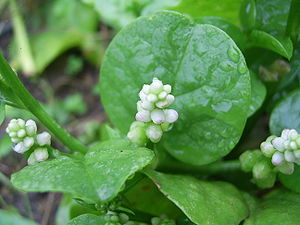Note: This is a project under development. The articles on this wiki are just being initiated and broadly incomplete. You can Help creating new pages.
Basella alba - Indian Spinach
Basella alba is a botanical name of Indian Spinach. Basella alba is known under various common names, including Malabar Spinach vine spinach.
Contents
[hide]- 1 Uses
- 2 Parts Used
- 3 Chemical Composition
- 4 Common names
- 5 Properties
- 6 Habit
- 7 Identification
- 8 List of Ayurvedic medicine in which the herb is used
- 9 Where to get the saplings
- 10 Mode of Propagation
- 11 How to plant/cultivate
- 12 Season to grow
- 13 Required Ecosystem/Climate
- 14 Kind of soil needed
- 15 Commonly seen growing in areas
- 16 Photo Gallery
- 17 References
- 18 External Links
Uses
Dysentery, Diuretic, Febrifuge, Catarrh, Boils, Conjunctivitis, Pimples, Diarrhea, Sore throats
Parts Used
Chemical Composition
The essential amino acids are arginine, leucine, isoleucine, lysine, threonine and tryptophan.[1]
Common names
| Language | Common name |
|---|---|
| Kannada | Bansali |
| Hindi | Poi |
| Malayalam | Vasalaccira |
| Tamil | Vasalakkirai |
| Telugu | Bachali, Bachchali-kura, Karubachali |
| Marathi | NA |
| Gujarathi | NA |
| Punjabi | NA |
| Kashmiri | NA |
| Sanskrit | Upodika |
| English | Indian spinach, Malabar Spinach |
Properties
Reference: Dravya - Substance, Rasa - Taste, Guna - Qualities, Veerya - Potency, Vipaka - Post-digesion effect, Karma - Pharmacological activity, Prabhava - Therepeutics.
Dravya
Rasa
Tikta (Bitter), Kashaya (Astringent)
Guna
Laghu (Light), Ruksha (Dry), Tikshna (Sharp)
Veerya
Ushna (Hot)
Vipaka
Katu (Pungent)
Karma
Kapha, Pitta
Prabhava
Habit
Identification
Leaf
| Kind | Shape | Feature |
|---|---|---|
| Simple | The leaves are divided into 3-6 toothed leaflets, with smaller leaflets in between |
Flower
| Type | Size | Color and composition | Stamen | More information |
|---|---|---|---|---|
| Unisexual | 2-4cm long | Yellow | 5-20 | Flowers Season is June - August |
Fruit
| Type | Size | Mass | Appearance | Seeds | More information |
|---|---|---|---|---|---|
| 7–10 mm (0.28–0.4 in.) long pome | Clearly grooved lengthwise, Lowest hooked hairs aligned towards crown | With hooked hairs | {{{6}}} |
Other features
List of Ayurvedic medicine in which the herb is used
Where to get the saplings
Mode of Propagation
How to plant/cultivate
Can be easily grown from seeds and cuttings.[3]
Season to grow
Cooler season[4]
Required Ecosystem/Climate
The plant thrives in hot humid climate. It requires moist, fertile and well-drained soil and is often cultivated in pots or in kitchen garden.[5]
Kind of soil needed
moist, fertile and well-drained soil
Commonly seen growing in areas
Moist places in hedges, Elevations around 500 metres in Nepal.
Photo Gallery
References
External Links
- Systematic pharmacognostical, phytochemical andpharmacological review on an ethno medicinal plant,Basella alba L.
- A review of the taxonomy, ethnobotany, phytochemistry and pharmacology of Basella alba
- Nutritional Analysis, Phytochemical Screening, and Total Phenolic Content of Basella alba Leaves from the Philippines
- Basella alba L on medicanal plants
- Ayurvedic Herbs known to be helpful to treat Dysentery
- Ayurvedic Herbs known to be helpful to treat Diuretic
- Ayurvedic Herbs known to be helpful to treat Febrifuge
- Ayurvedic Herbs known to be helpful to treat Catarrh
- Ayurvedic Herbs known to be helpful to treat Boils
- Ayurvedic Herbs known to be helpful to treat Conjunctivitis
- Ayurvedic Herbs known to be helpful to treat Pimples
- Ayurvedic Herbs known to be helpful to treat Diarrhea
- Ayurvedic Herbs known to be helpful to treat Sore throats
- Herbs with Leaves used in medicine
- Herbs with Stem used in medicine
- Herbs with common name in Kannada
- Herbs with common name in Hindi
- Herbs with common name in Malayalam
- Herbs with common name in Tamil
- Herbs with common name in Telugu
- Herbs with common name in Sanskrit
- Herbs with common name in English
- Habit - Perennial Climber
- Index of Plants which can be propagated by Seeds
- Index of Plants which can be propagated by Cuttings
- Herbs that are commonly seen in the region of Moist places in hedges
- Herbs that are commonly seen in the region of Elevations around 500 metres in Nepal
- Herbs
- Basellaceae






